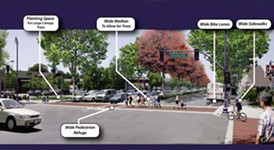Design Advocacy Voices: Austin
By Katherine Gregor, Fri., June 27, 2008
Brett Rhode, AIA, Rhode Partners:
I think it's a great idea. It would be nice to have something like DAG for Austin. I would certainly get involved with it. It can be pretty frustrating to see development projects go awry due to political wrangling. It would be great to have a group made up of a wider range of enlightened individuals to give a more unbiased opinion – outside of the de facto developer/city staff/neighborhood activist negotiations, which are often full of mistrust and missed opportunities.
Elizabeth Mueller, director of the Center for Sustainable Development, UT School of Architecture
Philadelphia is a bigger place and thus has many organizations interested in the city from various angles. We do not have the same density of civic organizations concerned about Austin or the strength of philanthropic support for such organizations (a crucial lack!). I do think that paying attention to building a beautiful city is important. We need a forum to talk about city issues that includes design/beauty, but connects it to other aspects of quality of life. A sort of Liveable City-plus design.
Mike Krusee, R-Round Rock:
Yes, it certainly would be of value here. We have no standards. Look at the current mishmash under construction. Now the city's about to award a contract for the redevelopment of Green Water [Treatment Plant site Downtown] four more blocks, without a clue about context – because there is none. Austin doesn't even know what a neighborhood is, beyond geography. Other cities are enriched by defined cultural districts; [to repeat known stereotypes] we have ... West (suburban rich), East (poor), Central (city rich), South (bubba).
Garner Stoll, AICP, city of Austin, assistant director, Neighborhood Planning and Zoning:
Yes, a similar group could be very helpful in bringing attention to the importance of three-dimensional perspectives on the built environment – particularly the quality of our public spaces and their relationship to adjacent buildings. Traditional land-use planning tends to focus on land-use compatibility issues, to the exclusion of active urban spaces as amenities and attractions.
Design advocacy groups are trying to focus the public's attention on the characteristics that people like about well-designed urban spaces and places. A similar group in Omaha is called Omaha by Design (www.omahabydesign.org). They have been working on Omaha's Urban Design Element of the [Master] Plan and Omaha Land Use Codes.
Richard Weiss, AIA, Design commissioner (with Ron Thrower and Stephen Oliver, AIA):
An urban design and planning reform agenda for Austin is necessary. Points it should address would include those below. None of these can stand alone; all are interconnected and must be holistically considered.
A. Neighborhoods and sustainable services/perhaps localized services
B. Cooperative connectivity (effective corridors, with transportation alternatives)
C. Town centers: embodied, manifested, and integrated with compact mix of uses and open public space
D. Affordability, and access to employment and services
E. Sustainable infrastructure, including coordination of utilities (critical)
Brewster McCracken, City Council member:
Austin would benefit from a citizen's advocacy group like DAG. We're pleased to see that someone else has one up and running.
Rachel Proctor May, Central Texas chapter vice president, Conference for the New Urbanism:
DAG looks similar to City Green of Austin [www.citygreenaustin.org] – Austin's voice for sustainable urbanism. We're talking about land use and sustainability issues – and great urban planning – but our focus is education, not advocacy. We're looking at green building, conservation, ideas for improving Austin's parks, transit, the built environment.
Jana McCann, ROMA Design Group:
I think DAG would be a great model for Austin, maybe using the Design Commission as the core group to build from, but allowing for more diversity in its membership. The nice thing about this group is the educational/outreach side of it, showing the design review process–recommendations, developer's response, etc., rather than having this all behind closed doors (even though these doors are technically open to anyone wanting to attend a commission meeting).
Dave Sullivan, Planning commissioner:
The Design Advocacy Group looks great to me, especially if they could help educate Austinites that size, scale, and proximity concerns can be offset by good design.
John Langmore, transportation consultant:
There can never be enough advocacy for design quality in architecture and physical planning. This is one of those issues that several groups have as part of their mission (CNU [Congress for New Urbanism], ECT [Envision Central Texas], AIA [American Institute of Architects], ULI [Urban Land Institute]) but none have as their exclusive mission.
The question becomes, is there a need – and enough community energy for – a separate group advocating exclusively for quality architecture and planning? Should this be the mission of the local CNU chapter? Some important questions we need to wrestle with and ultimately resolve. I do think some group needs to focus on advocacy (for these principles and maybe more) and move beyond merely educating.
To join a dialogue about starting a local group that advocates for good urban design and planning, e-mail: planaustin@yahoo.com.
Got something to say on the subject? Send a letter to the editor.








